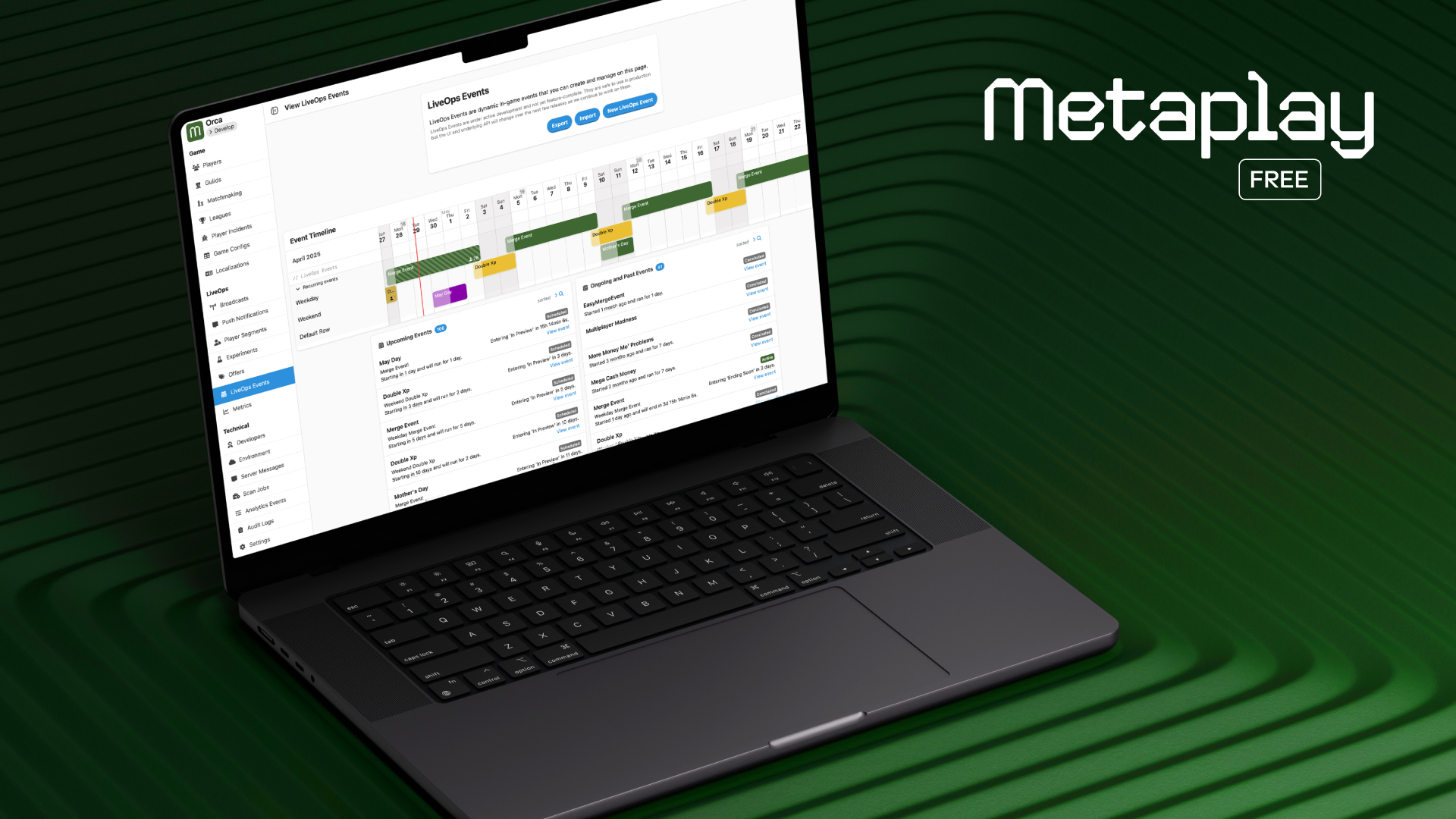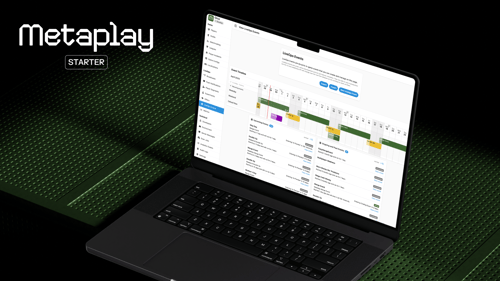
Announcing Metaplay Free

Emil Rosendahl •
We know firsthand just how much blood, sweat, and tears goes into building a great game. And as a team of seasoned game developers ourselves, we've lived through the frustration of wanting to build something big, but not having the tooling at our disposal to make it happen. Today, that changes.
We're delighted to announce Metaplay Free - a brand new Metaplay plan aimed at helping developers in teams of all sizes get their game off the ground on the same solid foundation as top-tier game studios.
Making Metaplay available to developers everywhere
Metaplay Free gives developers everywhere access to the full backend stack for local development, letting you start building ambitious features for your online game from day one.
You can work entirely locally, at your own pace, knowing that things are set up the right way from the outset of your project.
As you develop your game, you can simulate how it would feel for real by spinning up Metaplay's local server and leveraging the included BotClient tool to send bots to play it.
Then, using the included Metaplay LiveOps Dashboard, you'll be able to manage and administer those bot players in real-time as they play your game, and use Metaplay's full suite of LiveOps tooling like game config management, A/B testing, segmentation, and in-game event scheduling to embed LiveOps into your game from the very beginning - a crucial consideration for serious games today.
When you're ready to open up your game to players and publish online, deploying to the Metaplay Cloud and choosing your Metaplay Plan is simple in the Metaplay portal. Our team will handle the scaling and operations, so you can stay focused on building the next big hit.
Top-tier server architecture that's designed for massive scale
Unlike other game-backends-as-a-service, and, based on our experience of years of talking with game studios, Metaplay is server authoritative and by extension, cheat-proof by default.
Player actions are stored instantly on the server, which means there's no way for players to hack the client - an inevitability for any game as soon as it starts to achieve any kind of meaningful scale. With Metaplay, developers never even have to consider this becoming a problem.
Our advanced server architecture has also given us the opportunity to open up a world of new programming power tools for developers directly in the Unity SDK.

Code once, in C#, to program the client and the server simultaneously
At the heart of Metaplay is a developer superpower: shared game logic between the client and server.
You write your core game logic once in C#, and Metaplay runs it seamlessly on both the client and the server. That means no more double-implementing features, no more sync headaches, and no more having to re-write server features in a different language.
As well as for developers, this also unlocks a huge advantage for players. Server-authoritative games by design give all security and integrity of server-side validation, without forcing your players to suffer through sluggish network roundtrips. The client can instantly predict and respond to player actions using the exact same logic the server will later validate, giving your game the snappy responsiveness players today have come to expect as standard.
Fully extensible and customizable game backend
Game-backends-as-a-service have long suffered from the reputation of being black-boxes that don't cater to the needs of a particular game.
Metaplay was founded on a promise to change that. We know no two games are the same, which is why we ship Metaplay as source code and make everything extensible by design.
That means that as your game grows, you'll never be held back. Whatever you want to add to your game, you can - with Metaplay.
How to integrate Metaplay into your Unity game for free
Watch the quick two-minute tutorial video below to see how to integrate Metaplay into your game for free. If you’ve been curious about Metaplay or just want to explore a new backend setup, this is the perfect place to start.
Using Metaplay's new command-line interface tooling, you'll see how to download the Metaplay SDK to your machine, integrate it into your Unity project, spin up a local server, simulate sending players to your game, and get a feel for managing them for real in Metaplay's LiveOps Dashboard.
For a written guide on how to download Metaplay and integrate the Metaplay SDK into your Unity game for free, keep reading.
How to add the Metaplay SDK to your Unity game for free: A step-by-step guide
Here's a brief 8-step guide on how to quickly install Metaplay onto your machine and add it to your Unity project. For more context - and where to go next - check out our documentation at docs.metaplay.io.
1. Sign up for a Metaplay account in the Metaplay portal

2. Run brew install metaplay in your terminal console.

3. Copy the filepath of your Unity project into your terminal console, and, in that directory, run metaplay init project.

4. Choose the Metaplay organization and project you want to link your Unity project to. By default, you have these automatically generated for you when you sign up to the Metaplay portal. You can choose these, or create new ones if you like.

5. Now you're in! Metaplay should be integrated into your Unity project. Go back to your Unity project to check the Metaplay package has successfully installed. Then, back in terminal, run metaplay dev server to spin up your local Metaplay server.

6. With the local server running, we can already start sending simulated players to your game to get a feel for how you can manage them in real life. First, enable offline mode in Unity by selecting localhost from Environments in the Metaplay top menu.

6. Now, you're connected to the local host, open the Metaplay LiveOpsDashboard at http://localhost:5550. Your LiveOps Dashboard will open with an empty player server and no activity (yet!). This is where you'll manage your game though, so feel free to start looking around.

7. Let's start sending some players to your game. In a new terminal console in the same project directory, run metaplay dev botclient to run the Metaplay BotClient.

8. And hey presto! Now you can see players coming through to your game.

Keep going by following the rest of the steps in the Getting Started guide of the Metaplay docs. Now you're up and running, you can dive into how Metaplay handles data persistence, game logic and game configs - and start to experience of all the great things you can do with Metaplay.

How to publish your game with Metaplay
Metaplay Free is perfect for local development and testing. When it’s time to take your game live and scale with actual players, you'll need to upgrade to Metaplay Pro. That gives you the power to deploy to the Metaplay cloud.
Check out our pricing page for more info on plans, which include development, staging and production environments to fit your development stage.
You can now upgrade directly through your account in the Metaplay portal. We'll then quickly set you up to get you access to cloud hosting, server management, and advanced features necessary for managing large-scale games.
Start building for free with Metaplay today
What are you waiting for? Sign up for Metaplay Free today and start building with the same tech that's behind some of today's top games.




